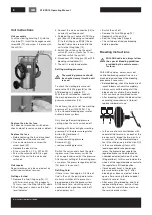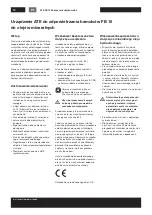
© Continental Aftermarket GmbH
8
ATE FB 15 Operating Manual
Unit instructions
Unit assembly
Push the steering handling (10) into the
stay tube (11). Insert the hexagon socket
screw M8 (12), and screw it in place with
the nut (13).
Replace the electric fuse
Unit does not work when switched on;
checks do not reveal any obvious defect:
Replace the fuse
• Before replacing the fuse, disconnect
the cable from the mains socket.
• Use a screwdriver to unscrew the
screw head (02)
• Remove the electric fuse
• Fit new fuse (230 V 2 A MT 5x20)
• Screw the screw head (02) in again
• Connect the unit to the mains and
switch on.
Unit repairs
Repair work may only be carried out by
authorized customer services.
Getting started
1. Remove the fluid filling cap (14), fill
with fluid – maximum filling capacity
15 liters–; seal the filling tube (15) again
2. The filling level is shown on the fluid-
level indicator
3. Connect the mains connector (05) to
a correctly earthed socket
4. To bleed the unit, connect ATE filling
gun (B) or ATE bleeding unit adapter
(C) to the filling hose (07/08); the ex-
tracted fluid can be returned to the
unit via the filling tube (15).
5. Switch the unit on using the on/off
switch (01), allow it to run for 10 sec.,
and then switch the unit off
6. Disconnect ATE filling gun (B) or ATE
bleeding unit adapter (C)
7. The unit is ready for operation
Setting working pressure
The working pressure should
be checked every time the unit
is used.
To check the working pressure set,
remove the ATE filling gun (B) or the
ATE bleeding unit adapter (C).
With the unit switched on, read off
the working pressure at the working-
pressure manometer (03).
On delivery, the unit is set to a working
pressure of 1 bar (100000 Pa). This
is the standard bleeding pressure for
hydraulic brake systems.
Only change the working pressure
setting when the unit is switched off.
Bleeding with lower or higher working
pressure: Pull the pressure regulator
button (04) to release it.
Screw in (
⟳
)
= increase working pressure
Screw out (
⟲
)
= reduce working pressure
Switch the unit on and check the work-
ing pressure. If necessary, switch the
unit on again and re-adjust the pressure.
After correct setting of the working pres-
sure, press the pressure regulator button
(04) back in to secure it.
Refilling fluid
If there is less than approx. 0.5 liters of
fluid in the unit, the pump motor auto-
matically switches off to prevent air
being pumped into the brake system.
At the same time, a buzzing noise is
sounded which signalizes switch-off
and an empty unit.
• Switch the unit off
• Remove the fluid filling cap (14)
• Replenish with new fluid
• Seal the filling tube (15) again
• The unit does not require bleeding
before operation
Bleeding instructions
With ABS vehicles always follow
the special bleeding guidelines
provided by the vehicle manu-
facturer.
With ABS vehicles, always carry out
controlled braking several times on a
blocked road and repeat the bleeding
procedure if necessary.
• Before bleeding, check the brake circuit
layout; bleed each circuit completely
• Always carry out bleeding at all the
bleed valves available. Some braking
units can have several bleed valves.
• After bleeding, tighten the bleed valves
according to requirements (torque);
replace rubber dust cap
• In the case of dual-circuit brakes with
separate fluid reservoirs on each of the
brake circuits, bleed the two circuits in
succession; first the intermediate pis-
ton (I) then the primary piston circuit (II)
• In the case of brake systems with
load-dependent brake power regu-
lators, the hydraulic passage to the
regulated brakes can be blocked on
unburdened axles (vehicle on 2-pillar
lifting platform). In this case, burden the
wheels of the regulated axles or actuate
the regulator in full-load position.
• If brake pedal travel is too long or
pressure build-up too “soft” after
bleeding has been carried out, bleed
again after pressing the brake pedal
forcefully several times.
• After every filling, bleeding, and fluid
replacement process, carry out leak-
age, function and efficiency tests on
the service brake system.
GB


































